31 Dec 2012-6 Jan 2013. We flew into Phnom Penh from Bangkok on New Years Eve, checked into our downtown hotel and went for an after-dinner walk along the paved open area beside the river. Everybody was out on the town, praying at street temples, walking, talking, riding bikes, the traffic was gridlocked and party was in the air. There were balloon sellers, and flower sellers, and everyone was doing something or going somewhere, piled three or four on a bike. The atmosphere was light, effervescent, and we let ourselves be swept along with it.



It was a great introduction to Phnom Penh. Now that we are no longer in Cambodia it feels safer to say that the government is probably one of the most corrupt in the world. If you’re in the government, or have the right connections, as one of Cambodia’s nouveau riche you will live in a big fancy mansion, possibly in a gated community, like this:

If not, meaning most people, you will probably struggle to make a living, barely making enough to get by. And yet what we mostly saw was a city of people simply getting on with their lives, one way or another; Buddhist monks making their morning alms rounds, kids playing, kids in school, adults going about their business. Lots of kids don’t get to go to school because although there is no charge, the teachers are not paid enough to live on so the kids must take money to pay the teacher and don’t go to school if they don’t have it. On the other hand we saw a facility where young children are being taught the traditional Khmer dances. There are beggars, mainly women and children all along “tourist row” – the downtown stretch of bars and restaurants along the street across from the river. I got used to the beggars in India, and quite frequently gave them money. In Cambodia it felt different. They seemed so desperate somehow, more so than those in India. We gave them money too. It’s such a drop in the ocean, no more than a momentary band-aid. Cambodia must be one of the poorest countries in the world, but for the most part we experienced the people to be warm, friendly, open and smiling.
When Pol Pot came into power, back in the 70’s, in complete insanity, he sent everyone in Phnom Penh, and other urban areas, to work in the fields, unless they were educated. The educated were killed. Even if a person just wore glasses they were killed. Within a week the entire city of Phnom Penh was empty. I can hardly fathom it. After his downfall people gradually came back to the city and simply claimed houses. Most of the people who’d originally owned them were dead.
But now, even though it’s a poor country, it begins to heal. People are resilient and make a living somehow. They get on with the business of living as best they can. It seemed such a contrast – the poverty, and then the sight of so many vehicles, and motorbikes, and businesses, and busy markets with plenty for sale. I don’t want to paint the picture that it’s all bad, particularly in the city. It was easy to make people smile. Sometimes I was lucky enough to catch it with the camera.
By chance one day, walking well away from “tourist row”, we discovered the thriving local market

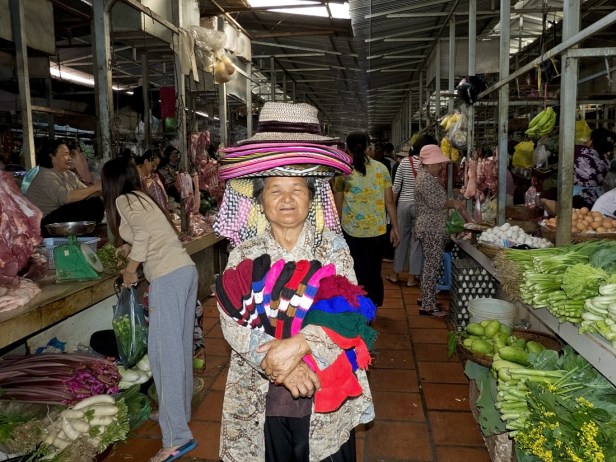
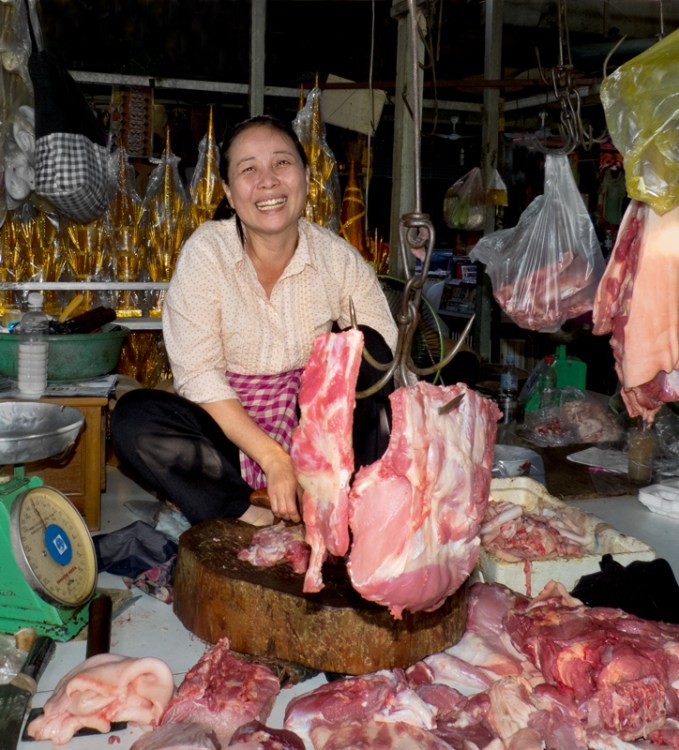
Buddhist monks make their rounds every morning, on foot, collecting alms, and saying prayers at businesses and homes.

This is the “food court” area of the night market where everyone, locals and tourists alike, gather for a picnic dinner and to watch performances.

And during the day in the same space we found these kids playing with their skateboards

Fishing for dinner in the Mekong

Traffic
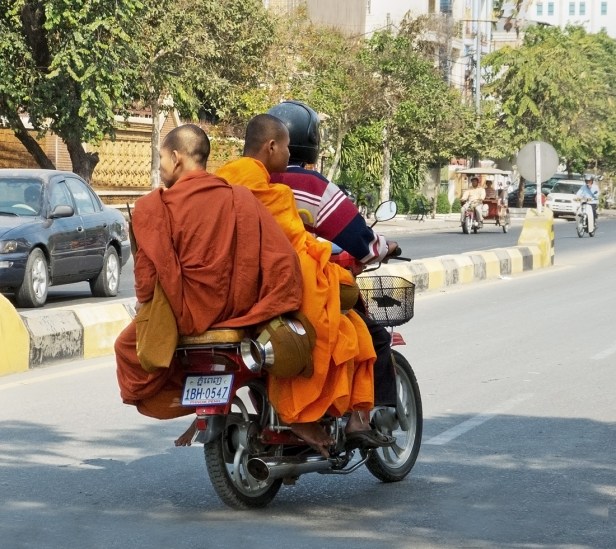
Sleeping child

We went for a day trip across the river to explore village life a little, though it could perhaps not be called a typical village since many people who live there work in Phnom Penh. It is not a rich village but is probably more prosperous than those further from the big city.
From the ferry we headed out on bikes. It had been a long time since we’d been on bikes – we’d forgotten how much we love it.

I stopped to take a picture of an old woman sitting on the stoop of her house with a child. I said to our guide that I thought she was not happy about it. He replied that she’s just very poor. I asked him to apologize for me, which he did. Her reply was “I wish she could help us”. One moment I’m feeling guilty for my intrusion, and sad for the plight of this woman and her family, and the next, just a bit further along the road, we find ourselves at the joyous occasion of a country wedding. Emotions flying up and down like a roller coaster. As usual I’m thrilled to come across a celebration. I love when that happens, when we get a glimpse into the special occasions, the ceremonies and rituals of the local people. With weddings it always amazes me how alike we all are, though I don’t know why it should.
The Grand Entrance

The Reception
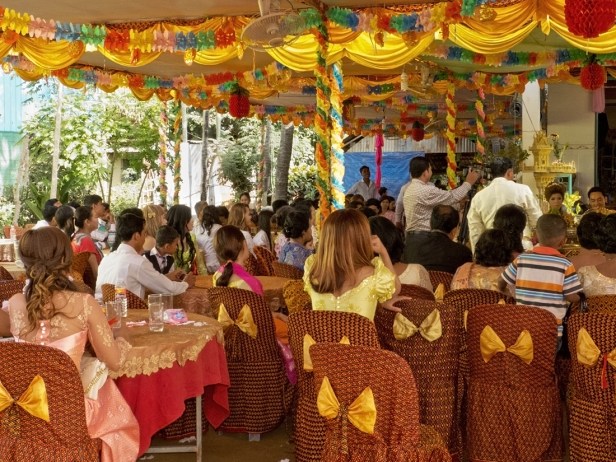
The bride and groom

We also visited a monastery

And a school. This classroom had a teacher, who probably moves back and forth between two class rooms.

This one did not. Don and I, and all the children, had so much fun taking photographs, except for one young girl on the left who remained very serious about getting her work done. No doubt we were a major distraction.

Homes along the Mekong across the river from Phnom Penh
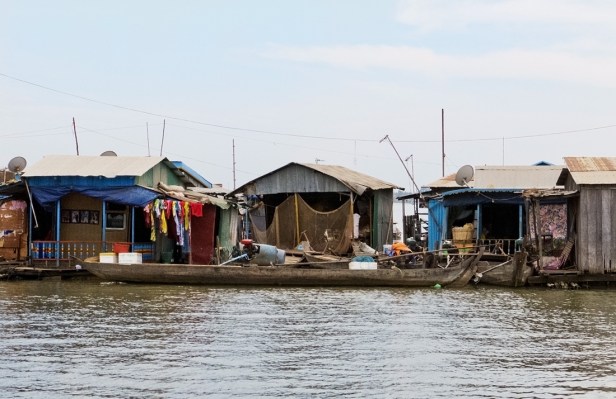
Returning to Phnom Penh on the ferry

We didn’t fall in love with Phnom Penh. That’s not the kind of place it is. The downtown area where all the hotels and restaurants and tourists are, alongside the river, is a little seedy, but across the street the wide walking-boulevard next to the Mekong River is just lovely. We have a friend who is currently living there. It was lovely to catch up with her, and to hear some first-hand information about how things are.
Next post: a floating village on the Tonle Sap River, and a pottery village.
All words and images by Alison Louise Armstrong unless otherwise noted.
© Alison Louise Armstrong and Adventures in Wonderland – a pilgrimage of the heart, 2010-2015.

A great series of photos, Alison. I almost feel as though I’m travelling with you. You bring the places you visit to life for me. Bless you, both. Safe travelling.
LikeLike
Thank you so much LizzieJoy. That is a great compliment, and much appreciated.
Blessings to you
Alison
LikeLike
The chicken is hilarious… hope the vendor and you aren’t offended, but I just about fell off my chair 😉 !
The food court draws me. I’m spreading out my blanket….
The photo of you two is my favorite of all your travel photos to date. You both look 20 years younger, so happy in a super-contented way, so fit, so at peace with yourselves.
LikeLike
Thanks Kate. Glad you got a good laugh out of it 🙂 I’m not remotely offended.
I like the photo of us on the bikes too. We must do more of that. It was a fun day.
So good to see you both – a wonderful visit.
xoxox
LikeLike
I can’t remember when I have seen so many genuine smiles. The kids, the vendors, you and Don, those smiles are priceless. Thank you for sharing this beautiful testament to the resiliency of the human spirit. I can’t imagine Phnom Penh empty after Pol Pot’s massacre. Luckily, the people and smiles are back. {{{hugs}}} Kozo
LikeLike
Thank you so much Kozo. It was so lovely to see people smile. It has been some time since the fall of Pol Pot’s regime, but the govt is still very corrupt and there’s no infrastructure to help people. It’s a poor country, but still most people smile and laugh and get on with life. But not all. And I so admire those people that are moved to help in a concrete, grass roots kind of way. Lots of help is still needed.
(((((Hugs))))) Alison
LikeLike
Such beautiful energy is streaming out of your photographs Alison and those smiles light up every shot you took. Thank you for sharing it with us 🙂
LikeLike
Thank you. What a lovely compliment. And I love having people to share it with, so thank you again 🙂
xoxox
LikeLike
Thanks for letting me camp out in your blog for a little while today. I had a great time and tried to leave my campsite as good as when I arrived. I’ll be back in a couple of weeks!
LikeLike
Hey thanks Russel. I’m glad to hear you had a good camping trip here 🙂
Look forward to seeing you again soon.
Cheers
Alison
LikeLike
thank you for sharing your trip into Cambodia. it is really shameful the rich ones can live without a bit of guilt when they see so many of their own people barely surviving. but, as you mentioned, they seem to have beautiful warm smiles when you catch them in a photograph. ♥
LikeLike
Yes it’s shameful. And the same the wide world over I think, just more exaggerated in some places. There’s no doubt there are very poor people in Cambodia, but most people, even though living in what we would call poverty, seem to make a living, and make a life, and are warm-hearted and friendly and quick to smile.
LikeLike
You really have scratched the surface of quite a few serious problems in Cambodia. But it is really insightful to hear mature travellers that are interested to find out about the Country they are visiting.
There are some wonderful charities doing really great work and I recommend those who are planning a longer stay to find out the ways that they can help and get more out of their modern travelling experiences.
I am looking forward to reading more about your Cambodian adventures!
LikeLike
Hi, thanks for visiting. I’m sure you’ve discovered the other posts on Cambodia. We certainly enjoyed our time there, but yes, I know I barely scratched the surface. So much to be done. At the same time I am always both buoyed and astonished by the resilience of the human spirit.
Thanks for your comment.
Alison
LikeLike